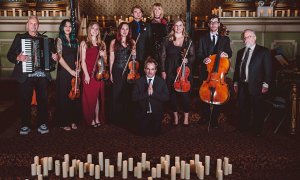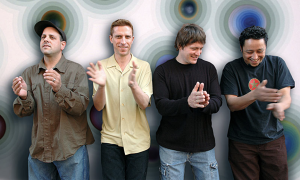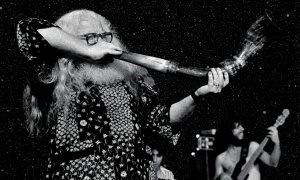Home » Jazz Articles » From the Inside Out » Adelante a Libertad! (Onward to Freedom!)
Adelante a Libertad! (Onward to Freedom!)
This is an extremely ego-less recording, where Bunnett

This set layers thirteen tracks from the Cubop roster of Afro-Cuban masters past and present into a thick forest of steamy, sweltering percussion funk.
Timbalero Bobby Matos was the first artist the label signed and is represented by “Kimbisa” from his album Footprints. Matos also produced “Back to the Roots,” a reminder that the marimba is a percussion instrument too, from Peligroso, the second Cubop album by marimba player Dave Pike. A longtime veteran of the Latin groove, Pike has graced sessions led by Bill Evans and Herbie Hancock and is also featured on Herbie Mann’s classic Family of Mann album.
It’s sometimes more foolish than brave to cover a song when a famous cover version already exists. But thanks to the hot and brilliant tenor saxophone of Charles Owens, conguero Francisco Aguabella rediscovers the sparkle of the Coltrane side to “My Favorite Things,” changing the beat on the last note of the two main melodic phrases just enough to make the rhythm flow differently behind Owens’ titanic tenor.
Other stalwarts are represented with “Bemba Colora” from Scorching the Skins by legendary conguero Jack Costanzo, universally credited with introducing the bongos to American jazz, and “My Dream Boogaloo” from Caliente Con Soul by Pucho & The Latin Soul Brothers. Prime movers in the virulently funky 1960s – ‘70s soul jazz strain known as boogaloo, timbalero Henry “Pucho” Brown and his Brothers continue to rock the beat hard – playfully, but hard. Another pillar of the Afro-Cuban community, Tito Puente is honored by British conguero/DJ Snowboy with “42nd & Broadway” from his tribute album Para Puente.
In addition, this set delivers a genuine collectors’ item with “Barrets Bag,” a teeth-rattling percussion explosion from the Har You Percussion Group, a fifteen-piece electric Latin / funk fusion big band which grew from a community service program designed to benefit young people in Harlem.
 Bill Summers & Irvin Mayfield: Los Hombres Calientes: Volume 4: Vodou Dance (Basin Street)
Bill Summers & Irvin Mayfield: Los Hombres Calientes: Volume 4: Vodou Dance (Basin Street)
Trumpet player Irvin Mayfield has been a primary shaper of the modern musical landscape of New Orleans: He serves as artistic director of the New Orleans Jazz Orchestra and as executive director and artistic director of the Institute of Jazz Culture at Dillard University in New Orleans, and has performed his own arrangements of spirituals and original works with the Louisiana Philharmonic Orchestra (2001 commission) and the Louisiana Philharmonic String Quartet. Mayfield also leads his own Quintet and performs with Bill Summers, an ethnomusicologist and percussionist who has worked with Herbie Hancock’s Headhunters, Stevie Wonder, and Quincy Jones, as Los Hombres Calientes.
In his inner sleeve notes, Summers writes, “This CD was done in love and respect for our ancestors who left this rich spiritual, artistic, and scientific legacy.” Los Hombres recognize this legacy by linking the major pieces of this set together with twelve tracks, credited as “traditional,” which are mostly vocal chant and percussion interludes from impromptu jam sessions with native folk musicians. Through these field recordings from Haiti, Brazil, Jamaica, and Trinidad, Volume 4: Vodou Dance ties the musical and cultural traditions of the Caribbean together with the Afro-Cuban and New Orleans jazz traditions.
Mileposts in Los Hombres’ journey include George Duke’s creamily pastel “Brazilian Sugar,” the languidly blue “Creole Groove,” the New Orleans classics “Jocimo” and rowdy “Wild Tchoupitoulas,” the reggae “Ghetto Get Up” and bristling “Latin Tinge.” “I Wouldn’t Have Religion,” testifying gospel howled and moaned in Greater Providence Baptist Church in New Orleans, helps bring it all back home.
Mayfield and Summers lead a expanding, contracting group which features pianist Victor Atkins, Edwin Livingston on bass, and Ricky Sebastian on drums; George Porter, Jr., of the Meters, Cyrille Neville, Santa Cruz of the Buena Vista Social Club, Big Chief Bo Dollis of the Wild Magnolias, and the Pamberi Steel Orchestra (recorded live in the rainforest of Port of Spain, Trinidad), are featured guests.

It almost never fails: Think to yourself just once, however quiet and solitary your thought, that by now you must have heard every type of music and instrumentation, and life is sure to drop on ya something that you’ve never heard before. El Gran Silencio has been that latest something new for me.
El Gran Silencio plays Mexican pop and rock, whipped as in a blender with other Mexican, Latin and world music. They came together when brothers Tony and Cano Hernández, who share vocal and guitar duties, joined up with bassist Vulgar Hernandez, drummer Ezequiel Alvarado and Isaac Valdez, one of the absolute baddest accordion players you’ll ever hear. Weary of bumming around in rock bands, the brothers yearned to create a sound that combined Mexican roots with rock, hip-hop, world beat and Indian music. They remain in their original home base of Monterrey, Mexico – but their sound stretches from Mexico to Seattle, to Spain, to India, to New York City and Los Angeles, and to Columbia.
Super Riddim Internacional Volume 1 digs especially into cumbia and other root sounds of Columbian norteno music. “We found that there are many styles in Columbian music besides cumbia,” said Hernández. “In the new record we do a little Columbian merengue, puya, porro and paseo.” Other international sounds come from authentic instrumentation: Middle Eastern darbuka, African chekere and yambe, and Columbian guacharaca, plus turntables (scratched by DJ Macojazz, Tony’s trip-hop alter-ego).
There are even more styles spread throughout these 17 tracks: The Caribbean sound of reggae snakes throughout “Sound System Municipal” and combines with a more traditional sound of Mexico in “Recuerdo y Lluvia,” while the rhythm of ska gives “Songbomb” its energetic pulse. The big beat reggae rap “Ingratos Corazones” culminates in a glorious cacophony of accordion, big beat bass and drums, and turntable scratches. Turntables also blend with accordion in the cutting low-rider rap “El Espejo.”
The title track is a frantic scramble through the accordion equivalent of “Wipeout,” done barrio style, while “Recordar es Vivir” boasts trumpet lines that sound like Lester Bowie rockin' the barrio, too. On the lighter side, “Sueño” beautifully blends ballad forms of Mexico and Spain, and “Buenos Dias” waves a warm and sunny greeting to a new day.
 Mongo Santamaria: Montreux Heat! (Pablo)
Mongo Santamaria: Montreux Heat! (Pablo)
Even if not quite essential, this new release is drawn from the same 1980 Montreux Jazz Festival performance from which Santamaria’s live recording Summertime was previously released (Pablo, 1981) – including all three encores – and so helps to complete a more well-rounded portrait of the legendary Afro-Cuban conguero/bonguero as the 1970s transitioned to the ‘80s. It’s Afro-Cuban jazz from someone who helped forge the mold.
More warm than hot, this is one more fitting coda to Mongo's illuminative and illustrious career. Surrounded by a tight band of longtime associates in Lee Smith (bass), Doug Harris (flute, tenor and soprano saxophones), and Steve Berrios (drums and percussion), plus Milton Hamilton (piano), Allen Hoist (flute, cello, and alto and baritone saxophones), and trumpet player Tommy Villarini, Santamaria almost never puts himself in the solo spotlight: “T.V.” is programmed for the bassist and for the composer and trumpet player whose initials comprise its title, “Sofrito” for pianist Hamilton, and “Pájaro Cantor” for the cellist...but Mongo only puts himself in the spotlight two times, for a few quick bars toward the end of “Pájaro Cantor” and even more briefly in the “Watermelon Man” mid-song break. Still, his bongos and congas rock the music hard and are indispensable to its groove.
The eleven-minute playing time for “Sofrito,” the set’s best performance, is misleading, as it opens with seven minutes of often breathtaking improvised piano, mostly solo but with occasional percussion counterpoint. Villarini breathes fire in his “T.V.” spotlight, in the second encore (“Amanacer”), and in “Sofrito,” scaling incendiary runs with the precision of a scalpel in daring, “dizzy”-ing fashion.
“Watermelon Man” features Dizzy Gillespie on trumpet and Toots Thielemans on harmonica. Though Harris and Thielemans each take two solo turns, Gillespie plays only the melody and horn counterpoint lines and does not solo.

Jane Bunnett: Cuban Odyssey (Blue Note)
Jane Bunnett visited Cuba for the first time in 1982, but in many ways – musically, at least – she has never really left.
This Odyssey presents music from Havana and three other locales recorded during her trip to Cuba with trumpeter, producer and husband Larry Cramer, featuring Bunnett on flute and soprano sax (she is also a trained classical pianist and clarinetist). Its mix of folklore, dance and party music, traditional and modern Afro-Cuban, and modern jazz styles, advances themes Bunnett has consistently explored with her Spirits of Havana ensemble. “This recording combines all we are about,” she allows. “It’s choral, solemn, rowdy, a folky son thing, hard-blowing jazz, traditional danzon and bolero tunes, lots of different vibes.”
Cuban Odyssey glows with warm feeling, like no matter where the music travels Bunnett is never too far from feeling at home. The journey begins in Havana with the party anthem “Quítate el Chaquetón (Take Off Your Jacket),” riotous revelry with a Cuban all-star band, including Gonzalo’s father Guillermo Rubalcaba, also a pianist. Later, Bunnett gloriously sways and wobbles with this same group through another classic party descarga, “Rum Con Rum (Rum with Rum).”
Bunnett also recorded (for the first time) with ensembles from Cuban locales outside of Havana. In the port city of Mantazas, Los Munequitos de Matanzas dance with Bunnett through “Suite Matanzas”; in Cienfuegos, her soprano squeals and laughs as it twirls with legendary son band Los Naranjos to face “El Diablo (The Devil).”
Bunnett recorded three haunting pieces in a cathedral in Camagüey with the ten-voice choir Descedann, composed of descendants of Haitian slaves and émigrés living in Cuba singing ancestral songs in their native patois. “Nan Fon Bwaa” solemnly aches and moans like the deepest, bluest African-American gospel and “Alabans” certainly sounds like it would fit in a liturgical service.
When she affords herself room, Bunnett proves an adventurous and energetic soloist, as in the opening “Arrival,” her forward-looking soprano sax accompanied only by percussion and bata drums, and in “Pensando en Jane,” where her saxophone shreds through the chart like passionate Coltrane singing in his soprano voice. But this is an extremely ego-less recording, where Bunnett’s love of the music proves stronger than her love of self.
Comments
Tags
For the Love of Jazz
 All About Jazz has been a pillar of jazz since 1995, championing it as an art form and, more importantly, supporting the musicians who create it. Our enduring commitment has made "AAJ" one of the most culturally important websites of its kind, read by hundreds of thousands of fans, musicians and industry figures every month.
All About Jazz has been a pillar of jazz since 1995, championing it as an art form and, more importantly, supporting the musicians who create it. Our enduring commitment has made "AAJ" one of the most culturally important websites of its kind, read by hundreds of thousands of fans, musicians and industry figures every month.






















